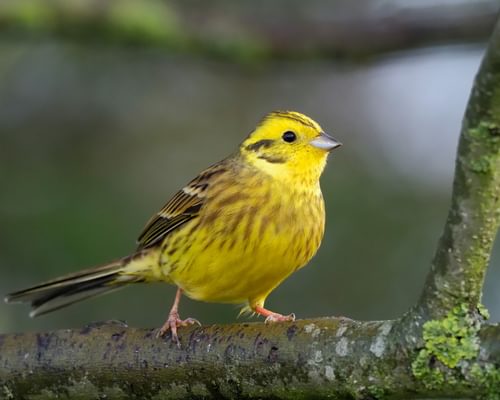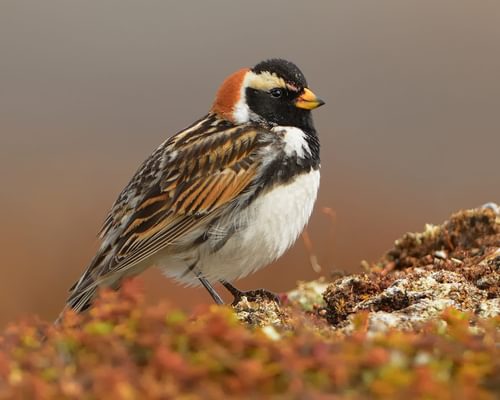Reed Bunting
Least ConcernEmberiza schoeniclus
Visual Identification
Appearance
The Reed Bunting is a small, sparrow-sized bird with distinctive markings. Males in breeding plumage have a black head and throat, white collar, and moustache stripe. Their back is streaked brown, with white outer tail feathers.
Females and non-breeding males are more subtly coloured, with a brown-streaked head and pale supercilium. Both sexes have pinkish-brown legs and a grey, conical bill.
Juveniles are similar to adult females but with chestnut crowns, yellow and buff underparts, and heavier streaking overall.
Size
Length
13.5cm to 15.5cm
Wingspan
21cm to 28cm
Weight
15g to 23g
Habitat and Distribution
Habitats
Woodland
Garden
Wetland
Coastal
Urban
Farmland
Grassland
Desert
Tundra
Rainforest
Mountain
Savanna
Distribution
Reed Buntings inhabit wetlands, reedbeds, and damp areas across Europe and Asia. They are particularly common in marshes, wet meadows, and along the edges of lakes and rivers.
In the UK, they are widespread breeding residents, with numbers boosted by winter migrants from northern Europe. During colder months, they may move to drier habitats, including farmland and coastal areas.
Elevation Range
Up to 2,000 meters
Climate zones
Temperate, Subarctic
Distribution Map
This map gives you a rough idea of where you might spot a Reed Bunting. The coloured areas show countries where these birds have been seen.
A few things to keep in mind:
- Birds might not be everywhere in the coloured areas, for example, they may be present around the coast of that country
- Where birds live can change with seasons and available food
- This map is quite simple - it doesn't show exact locations
We're working on making our maps even better! Soon, we hope to show you:
- More detailed maps for bigger countries, including state and region
- How birds move around during different seasons
Distribution by Region
Behaviour and Ecology
Bird Attributes
This feature is in beta. We'd love your feedback to improve it!
Share your thoughtsBird Attributes Explained
Our bird attributes system rates various aspects of a bird's capabilities on a scale of 0-100, based on data from field observations, scientific studies, and expert knowledge.
Attribute Categories:
- Agility: Manoeuvrability, speed, and grace in flight or movement.
- Strength: Physical power, often correlating with size and hunting abilities.
- Adaptability: Ability to thrive in various environments or changing conditions.
- Aggressiveness: Territorial behaviour and assertiveness, particularly during breeding seasons.
- Endurance: Stamina, often seen in migration patterns or foraging behaviours.
Understanding the Ratings:
- 0-20: Very Low
- 21-40: Low
- 41-60: Average
- 61-80: High
- 81-100: Very High
Remember, these attributes are relative to other bird species and don't necessarily indicate superiority.
Hover over the icon next to each attribute for more information.
Tap the icon next to each attribute for more information.
Agility
Reflects the bird's manoeuvrability, speed, and grace in flight or movement.
The Reed Bunting displays considerable agility, as evidenced by its ability to navigate through dense reedbeds and vegetation. Its undulating flight pattern and capacity to perch atop slender reeds suggest good manoeuvrability. The bird's aptitude for foraging low in vegetation and hopping along the ground also indicates a fair degree of nimbleness.
Strength
Indicates the bird's physical power, often correlating with size and hunting abilities.
As a small, sparrow-sized bird weighing between 15-23 grams, the Reed Bunting possesses limited strength relative to larger avian species. However, it demonstrates sufficient strength for its size to perform necessary tasks such as nest-building and defending territories.
Adaptability
Represents the bird's ability to thrive in various environments or changing conditions.
Reed Buntings show remarkable adaptability. They can thrive in various wetland habitats, adjust their diet seasonally between seeds and insects, and have even adapted to nesting in crops like oilseed rape in some areas. Their ability to shift to drier habitats during winter months further demonstrates their adaptable nature.
Aggressiveness
Measures the bird's territorial behaviour and assertiveness, particularly during breeding seasons.
While not overtly aggressive, male Reed Buntings display territorial behaviour during breeding season, engaging in aerial displays and defending their territories. The potential for multiple female partners suggests some level of competitive behaviour. However, they are not known for exceptional aggression compared to other bird species.
Endurance
Reflects the bird's stamina, often seen in migration patterns or foraging behaviours.
Reed Buntings exhibit moderate endurance. As partial migrants, some populations undertake seasonal movements, indicating a degree of stamina. Their ability to survive in various climates, from temperate to subarctic, suggests resilience. However, their relatively small size and short lifespan (3-5 years) limit their overall endurance rating.
Diet
Reed Buntings primarily feed on seeds, especially those of sedges and grasses. During the breeding season, they supplement their diet with insects and spiders, which are crucial for feeding their young. In winter, they may visit bird feeders in gardens near their preferred habitats.
Invertebrates commonly foraged include spiders, caterpillars, beetles, larvae, dragonflies, mayflies, ticks and crustaceans. The most popular seeds are birch, spruce, alder and nettle.
Foraging takes place on the ground and in low vegetation.
Behaviour
Reed Buntings are often seen perched atop reeds or bushes, singing or surveying their territory. They forage low in vegetation, hopping along the ground to search for seeds and insects.
During the breeding season, males become territorial and engage in aerial displays to attract mates.
Vocalisation
The male Reed Bunting's song is a simple, repetitive series of squeaky notes, often described as "zhi-zhi-zhi-zher-zher". Their call is a sharp "tseeu" or a softer "tsi". During courtship, males may produce a more complex and varied song to attract females.
Nesting & Breeding
Breeding season for Reed Buntings typically begins in April. Males establish territories and attract females with song flights and displays.
Females construct cup-shaped nests low in vegetation, often near the ground in reeds or tussocks. They lay 4-5 eggs, which are pale blue-grey with dark markings.
Incubation lasts about 13 days, and the female is primarily responsible for it. Both parents feed the chicks, who fledge after 10-13 days but remain dependent on the adults for another two weeks.
Lifespan
The Reed Bunting typically lives for 3 to 5 years, with a maximum recorded lifespan of 12.2 years.
Like all birds, lifespan can be affected by factors including predation, habitat quality, disease, and access to food sources.
Conservation and Status
Global Conservation Status
While listed as Least Concern globally, Reed Bunting populations have declined in some areas due to habitat loss and agricultural intensification.
Conservation efforts focus on preserving wetlands and promoting wildlife-friendly farming practices to maintain suitable breeding habitats.
Birdwatching Tips
- Look for Reed Buntings near wetlands, reedbeds, and damp meadows
- Listen for the male's simple, repetitive song, often delivered from a prominent perch
- Observe their distinctive undulating flight pattern
- In the UK, check farmland hedgerows during the winter months
Additional Information
Quick Facts
Other names:
Common Reed Bunting
Family:
EmberizidaePredators
Did You Know?
- Reed Buntings can swim short distances if necessary to escape predators.
- In some areas, they have adapted to nest in crops like oilseed rape.
- Male Reed Buntings may have multiple female partners in a single breeding season.
Was this bird profile helpful?
Your feedback helps us improve our content
Thanks for your feedback!
Your input helps us improve our content.
Community Experience
Community Ratings
No ratings yet - be the first to rate this bird!
Latest Community Reviews
No reviews yet
Sign in to be the first to review
Community Reviews
Create Your Free Account Welcome Back!
Join our community to rate birds and share your experiences. Creating an account is completely free and only takes a minute. Sign in to your account to rate birds and share your experiences with our community.
Your information is secure and will never be shared.
By creating an account, you agree to our Privacy Policy.
Similar Birds
References
- 2 3
website: BirdLife International. 2019. Emberiza schoeniclus (amended version of 2018 assessment). The IUCN Red List of Threatened Species 2019: e.T22721012A155430396.
View source - 4
report, 2015: EBCC
- 1
website, 2010: Fransson et al., EURING list of longevity records for European birds
View source

